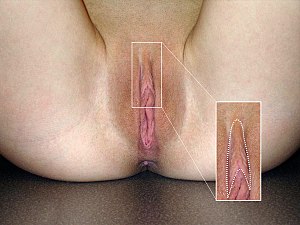Difference between revisions of "Clitoral hood"
(created and adapted from WP content) |
WikiModEn2 (talk | contribs) (Add category.) |
||
| (11 intermediate revisions by 2 users not shown) | |||
| Line 1: | Line 1: | ||
{{GraphicWarning}} | {{GraphicWarning}} | ||
| − | [[File:Clitoris_outer_anatomy.png|thumb|Outer anatomy of clitoris]] | + | [[File:Clitoris_outer_anatomy.png|thumb|Outer anatomy of [[clitoris]]]] |
| − | [[File:Clitoral hood.jpg|thumb|A photograph of a human vulva with a labeled clitoral hood]] | + | [[File:Clitoral hood.jpg|thumb|A photograph of a human [[vulva]] with a labeled clitoral hood]] |
{{WikipediaQuote|URL=https://en.wikipedia.org/wiki/Clitoral_hood|title=Clitoral Hood}} | {{WikipediaQuote|URL=https://en.wikipedia.org/wiki/Clitoral_hood|title=Clitoral Hood}} | ||
<blockquote> | <blockquote> | ||
| − | In female human anatomy, the '''clitoral hood''' (also called '''preputium clitoridis''' and '''clitoral prepuce''') is a fold of [[skin]] that surrounds and protects the [[clitoral glans|glans]] of the [[clitoris]]; it also covers the external shaft of the clitoris, develops as part of the [[labia minora]] and is [[homology (biology)|homologous]] with the [[foreskin]] (equally called ''prepuce'') in [[Sex organ|male genitals]].<ref name="Sloane">{{REFbook | + | In female human anatomy, the '''clitoral hood''' (also called '''preputium clitoridis''' and '''clitoral prepuce''') is a fold of [[skin]] that surrounds and protects the [[clitoral glans|glans]] of the [[clitoris]]; it also covers the external shaft of the [[clitoris]], develops as part of the [[labia minora]] and is [[homology (biology)|homologous]] with the [[foreskin]] (equally called ''prepuce'') in [[Sex organ|male genitals]].<ref name="Sloane">{{REFbook |
| + | |last=Sloane | ||
|first=Ethel | |first=Ethel | ||
| − | | | + | |init=E |
|title=Biology of Women | |title=Biology of Women | ||
|publisher=Cengage Learning | |publisher=Cengage Learning | ||
| Line 16: | Line 17: | ||
|url=https://books.google.com/books?id=kqcYyk7zlHYC&q=Helen+Connell+clitoris+1998&pg=PA32 | |url=https://books.google.com/books?id=kqcYyk7zlHYC&q=Helen+Connell+clitoris+1998&pg=PA32 | ||
}}</ref><ref name="Crooks">{{REFbook | }}</ref><ref name="Crooks">{{REFbook | ||
| + | |last=Crooks | ||
|first=Robert | |first=Robert | ||
| − | | | + | |init=R |
| + | |last2=Baur | ||
|first2=Karla | |first2=Karla | ||
| − | | | + | |init2=K |
|title=Our Sexuality | |title=Our Sexuality | ||
|publisher=Cengage Learning | |publisher=Cengage Learning | ||
| Line 28: | Line 31: | ||
|url=https://books.google.com/books?id=MpRnPtmdRVwC&q=The+clitoral+glans+in+particular+is+highly+sensitive&pg=PA54 | |url=https://books.google.com/books?id=MpRnPtmdRVwC&q=The+clitoral+glans+in+particular+is+highly+sensitive&pg=PA54 | ||
}}</ref><ref name="Mulhall">{{REFbook | }}</ref><ref name="Mulhall">{{REFbook | ||
| + | |last=Mulhall | ||
|first=John P. | |first=John P. | ||
| − | | | + | |init=JP |
| − | | | + | |editors=John P. Mulhall, Luca Incrocci, Irwin Goldstein, Ray Rosen |
|editor2=Luca Incrocci | |editor2=Luca Incrocci | ||
|editor3=Irwin Goldstein | |editor3=Irwin Goldstein | ||
| Line 43: | Line 47: | ||
}}</ref> | }}</ref> | ||
| − | The clitoral hood is composed of [[Mucocutaneous zone|muccocutaneous]] tissues; these tissues are between the [[mucosa]] and the skin, and they may have immunological importance because they may be a point of entry of | + | The clitoral hood is composed of [[Mucocutaneous zone|muccocutaneous]] tissues; these tissues are between the [[mucosa]] and the [[skin]], and they may have immunological importance because they may be a point of entry of [[mucosa]]l vaccines.<ref name="Cold and Taylor">{{ColdCJ TaylorJR 1999}}</ref> The clitoral hood is also important not only in protection of the [[clitoral glans]], but also in pleasure, as it is an [[Erogenous zone|erogenous]] tissue.<ref name="Cold and Taylor"/> |
| − | |||
| − | |||
| − | |||
| − | |||
| − | |||
| − | |||
| − | |||
| − | |||
| − | |||
| − | |||
| − | |||
| − | |||
| − | |||
| − | |||
| − | }}</ref> The clitoral hood is also important not only in protection of the clitoral glans, but also in pleasure, as it is an [[Erogenous zone|erogenous]] tissue.<ref name="Cold and Taylor"/> | ||
==Development and variation== | ==Development and variation== | ||
| − | The clitoral hood is formed during the [[Fetus|fetal]] stage by the cellular lamella.<ref name="Cold and Taylor"/> The cellular lamella grows down on the [[dorsal side]] of the clitoris and is eventually fused with the clitoris. The clitoral hood is formed from the same tissues that form the foreskin in human males. | + | The clitoral hood is formed during the [[Fetus|fetal]] stage by the cellular lamella.<ref name="Cold and Taylor"/> The cellular lamella grows down on the [[dorsal side]] of the [[clitoris]] and is eventually fused with the [[clitoris]]. The clitoral hood is formed from the same tissues that form the [[foreskin]] in human males. |
| − | The clitoral hood varies in the size, shape, thickness, and other aesthetic areas. Some women have large clitoral hoods that completely cover the clitoral glans. Some of these can be retracted to expose the clitoral glans, such as for hygiene purposes or for pleasure; others do not retract. Other women have smaller hoods that do not cover the full length of the clitoral glans, leaving the clitoral glans exposed all the time. Sticky bands of tissue called ''adhesions'' can form between the hood and the glans; these stick the hood onto the glans so the hood cannot be pulled back to expose the glans, and, as in the male, strongly scented [[smegma]] can accumulate. | + | The clitoral hood varies in the size, shape, thickness, and other aesthetic areas. Some women have large clitoral hoods that completely cover the [[clitoral glans]]. Some of these can be retracted to expose the [[clitoral glans]], such as for hygiene purposes or for pleasure; others do not retract. Other women have smaller hoods that do not cover the full length of the [[clitoral glans]], leaving the [[clitoral glans]] exposed all the time. Sticky bands of tissue called ''adhesions'' can form between the hood and the glans; these stick the hood onto the glans so the hood cannot be pulled back to expose the glans, and, as in the male, strongly scented [[smegma]] can accumulate. |
</blockquote> | </blockquote> | ||
| Line 73: | Line 62: | ||
{{REF}} | {{REF}} | ||
| − | + | [[Category:Genital]] | |
| + | [[Category:Female sexuality]] | ||
| − | [[ | + | [[de:Klitorisvorhaut]] |
Latest revision as of 17:20, 4 January 2023


(The following text or part of it is quoted from the free Wikipedia article Clitoral Hood
:)
In female human anatomy, the clitoral hood (also called preputium clitoridis and clitoral prepuce) is a fold of skin that surrounds and protects the glans of the clitoris; it also covers the external shaft of the clitoris, develops as part of the labia minora and is homologous with the foreskin (equally called prepuce) in male genitals.[1][2][3]
The clitoral hood is composed of muccocutaneous tissues; these tissues are between the mucosa and the skin, and they may have immunological importance because they may be a point of entry of mucosal vaccines.[4] The clitoral hood is also important not only in protection of the clitoral glans, but also in pleasure, as it is an erogenous tissue.[4]
Development and variation
The clitoral hood is formed during the fetal stage by the cellular lamella.[4] The cellular lamella grows down on the dorsal side of the clitoris and is eventually fused with the clitoris. The clitoral hood is formed from the same tissues that form the foreskin in human males.
The clitoral hood varies in the size, shape, thickness, and other aesthetic areas. Some women have large clitoral hoods that completely cover the clitoral glans. Some of these can be retracted to expose the clitoral glans, such as for hygiene purposes or for pleasure; others do not retract. Other women have smaller hoods that do not cover the full length of the clitoral glans, leaving the clitoral glans exposed all the time. Sticky bands of tissue called adhesions can form between the hood and the glans; these stick the hood onto the glans so the hood cannot be pulled back to expose the glans, and, as in the male, strongly scented smegma can accumulate.
References
- ↑
 Sloane E (2002): Biology of Women. Cengage Learning. P. 32. ISBN 0766811425. Retrieved 25 August 2012.
Sloane E (2002): Biology of Women. Cengage Learning. P. 32. ISBN 0766811425. Retrieved 25 August 2012.
- ↑
 Crooks R, Baur K (2010): Our Sexuality. Cengage Learning. Pp. 54. ISBN 978-0495812944. Retrieved 30 August 2012.
Crooks R, Baur K (2010): Our Sexuality. Cengage Learning. Pp. 54. ISBN 978-0495812944. Retrieved 30 August 2012.
- ↑
 Mulhall JP (2011): Cancer and Sexual Health. John P. Mulhall, Luca Incrocci, Irwin Goldstein, Ray Rosen (eds.). Springer Publishing. Pp. 13–22. ISBN 978-1-60761-915-4. Retrieved 23 June 2012.
Mulhall JP (2011): Cancer and Sexual Health. John P. Mulhall, Luca Incrocci, Irwin Goldstein, Ray Rosen (eds.). Springer Publishing. Pp. 13–22. ISBN 978-1-60761-915-4. Retrieved 23 June 2012.
- ↑ a b c
 Cold CJ, Taylor JR. The prepuce. BJU Int. January 1999; 83, Suppl. 1: 34-44. PMID. DOI. Retrieved 8 July 2021.
Cold CJ, Taylor JR. The prepuce. BJU Int. January 1999; 83, Suppl. 1: 34-44. PMID. DOI. Retrieved 8 July 2021.
